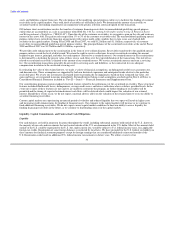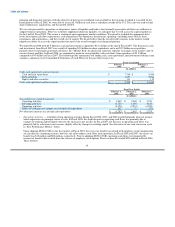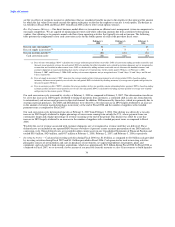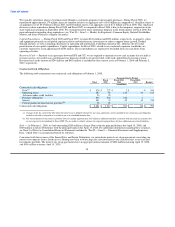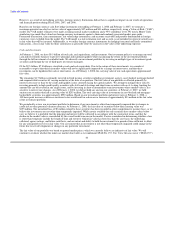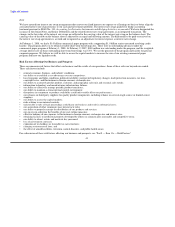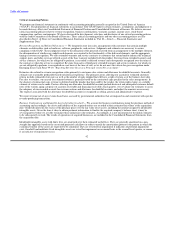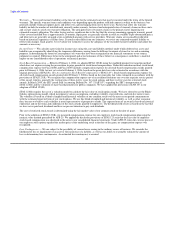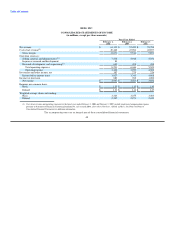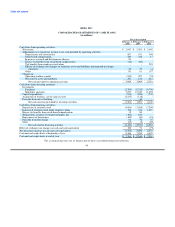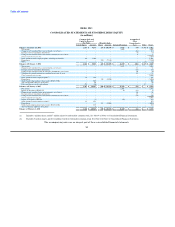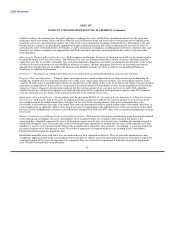Dell 2007 Annual Report Download - page 46
Download and view the complete annual report
Please find page 46 of the 2007 Dell annual report below. You can navigate through the pages in the report by either clicking on the pages listed below, or by using the keyword search tool below to find specific information within the annual report.
Table of Contents
Critical Accounting Policies
We prepare our financial statements in conformity with accounting principles generally accepted in the United States of America
("GAAP"). The preparation of financial statements in accordance with GAAP requires certain estimates, assumptions, and judgments to
be made that may affect our Consolidated Statement of Financial Position and Consolidated Statement of Income. We believe our most
critical accounting policies relate to revenue recognition, business combinations, warranty accruals, income taxes, stock-based
compensation, and loss contingencies. We have discussed the development, selection, and disclosure of our critical accounting policies
with the Audit Committee of our Board of Directors. These critical accounting policies and our other accounting policies are also
described in Note 1 of Notes to Consolidated Financial Statements included in "Part II — Item 8 — Financial Statements and
Supplementary Data."
Revenue Recognition and Related Allowances — We frequently enter into sales arrangements with customers that contain multiple
elements or deliverables such as hardware, software, peripherals, and services. Judgments and estimates are necessary to ensure
compliance with GAAP. These judgments relate to the allocation of the proceeds received from an arrangement to the multiple elements,
the determination of whether any undelivered elements are essential to the functionality of the delivered elements, and the appropriate
timing of revenue recognition. We offer extended warranty and service contracts to customers that extend and/or enhance the technical
support, parts, and labor coverage offered as part of the base warranty included with the product. Revenue from extended warranty and
service contracts, for which we are obligated to perform, is recorded as deferred revenue and subsequently recognized over the term of
the contract or when the service is completed. Revenue from sales of third-party extended warranty and service contracts, for which we
are not obligated to perform, is recognized on a net basis at the time of sale, as we do not meet the criteria for gross recognition under
Emerging Issues Task Force 99-19, "Reporting Revenue Gross as a Principal versus Net as an Agent."
Estimates also related to revenue recognition relate primarily to customer sales returns and allowance for doubtful accounts. Generally,
estimates are reasonably predictable based on historical experience. The primary factors affecting our accrual for estimated customer
returns include estimated return rates as well as the number of units shipped that still have a right of return as of the balance sheet date.
For sales to retailers, our accrual for estimated returns is generally based on the contractual caps specified in the sales arrangements. In
the absence of contractual caps, revenue is deferred until the product has been sold by the retailer, the return rights expire, or a reliable
estimate of returns can be made. Factors affecting our allowance for doubtful accounts include historical and anticipated customer default
rates of the various aging categories of accounts receivable and financing receivables. Each quarter, we reevaluate our estimates to assess
the adequacy of our recorded accruals for customer returns and allowance for doubtful accounts, and adjust the amounts as necessary.
The expense associated with the allowance for doubtful accounts is recognized as selling, general, and administrative expense.
We report revenue net of any revenue-based taxes assessed by governmental authorities that are imposed on and concurrent with specific
revenue-producing transactions.
Business Combinations and Intangible Assets Including Goodwill — We account for business combinations using the purchase method of
accounting and accordingly, the assets and liabilities of the acquired entities are recorded at their estimated fair values at the acquisition
date. Goodwill represents the excess of the purchase price over the fair value of net assets, including the amount assigned to identifiable
intangible assets. Given the time it takes to obtain pertinent information to finalize the acquired company's balance sheet, it may be
several quarters before we are able to finalize those initial fair value estimates. Accordingly, it is not uncommon for the initial estimates
to be subsequently revised. The results of operations of acquired businesses are included in the Consolidated Financial Statements from
the acquisition date.
Identifiable intangible assets with finite lives are amortized over their estimated useful lives. They are generally amortized on a non-
straight-line approach based on the associated projected cash flows in order to match the amortization pattern to the pattern in which the
economic benefits of the assets are expected to be consumed. They are reviewed for impairment if indicators of potential impairment
exist. Goodwill and indefinite lived intangibles assets are tested for impairment on an annual basis in the second fiscal quarter, or sooner
if an indicator of impairment occurs.
42




